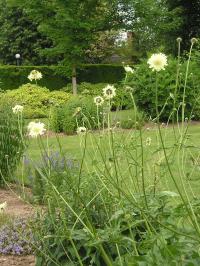Land of the Giant Scabious

A plant profile of Cephalaria gigantea and the secret to a successful Moussaka: Tips on growing your own Aubergines. Also, Powdery or Downy? How to tell the difference between the two main types of mildew.
If you have a love of plants, and want to study them in any detail it helps if you also have interest in Geography. Finding out about the native habitat of a plant is not only very interesting, it is also very helpful if you are to grow a particular plant successfully.
The Caucasus is a mountainous area of South Eastern Europe. It lies between the Caspian Sea and the Black Sea, covering areas of Georgia, Armenia, Azerbaijan and South Eastern Russia. Some of the mountains in this region have altitudes of nearly 6,000 meters; that's nearly 4 miles above sea level.
High up on these mountain-sides lives a giant of the plant world. Cephalaria gigantea (Giant Scabious) (pictured) literally grows with it's head in the clouds!
Also a native of Northern Turkey, Cephalaria giagantea can also be found growing alongside rivers, streams and damp meadows. I wonder if this tendency to grow near water has something to do with the phenomenal growth rate of Giant Scabious. Having a constant supply of moisture at the roots must give any plant a head start, especially one that can grow from 0 to 3 meters in a matter of months. Yes, that's right, Giant Scabious can grow from a non-visible over-wintering rootstock to 8ft in a single season! The nomenclature status of Cephalaria giagantea is a little confused. You would expect a Giant Scabious to be a member of the Scabiosa Genus. Alas, no, the only relationship between a "normal" Scabious and a Giant Scabious is that they belong in the same family, not the same Genus. I won't go any further than that, it gets too confusing, just imagine Giant Scabious as a cousin of a Scabious, rather than a brother or sister.
Cephalaria gigantea is flowering now in many gardens. Despite the size of the plant itself, the flowers are relatively small, only being about 5cm across. The flowers look like pincushions and are light butter-yellow in colour.
Below the flower stems, a clump of deeply cut mid-green leaves is formed. As you would expect from the altitudes at which it grows in the wild, Cephalaria gigantea is a very hardy plant.
So, if you can provide nutritious, rich, moist soil and a reasonable amount of sun, get hold of some Cephalaria giagantea. If you have any Giant Sunflowers, it may well compete with them!
Mildew
How is your garden coping with this long, hot summer? One sign of drought and a sure sign that plants are suffering due to a lack of moisture at the roots is the presence of Powdery Mildew in the garden. There is often some confusion over the different types of mildew. Basically there are two types.
Downy Mildew is usually associated with damp conditions and is usually found on the undersides of plant foliage. But it is Powdery Mildew that you are most likely to come across in your garden at the moment. This hot, dry weather and long periods of drought are ideal for Powdery Mildew that thrives in such conditions. There are many different types of Powdery mildew fungi, each affecting a specific plant or a group of closely related plants. Powdery Mildew is white and it has a floury-like consistency, usually found on the upper leaf surfaces.
If you are experiencing a hosepipe ban there is not an awful lot you can do about Powdery Mildew. Affected plants need to be kept well watered and the parts of the plant that have the fungi on them should be pruned out. Mulching around the base of plants to try and reduce water evaporation from the root zone will also help. "Good housekeeping" is also important as any leaves that fall due to Powdery Mildew will be a source of contamination in the next growing season if they are not cleared up.
Growing Aubergines
One vegetable plant that might suffer from Powdery Mildew is Solanum melongena, a relation of the potato and more commonly known as the Aubergine. I have been asked this week on the PlantAdvice Forum about growing Aubergines. If you have any specific questions to ask about anything at all to do with plants or gardening please use our Forum, it is completely free to use and a great way to expand your horticultural knowledge by sharing questions and answers with other green-fingered enthusiasts.
Aubergines, sometimes known as Egg plants can be grown in the U.K. if you can provide the optimum growing conditions. You have to remember that they are tropical/sub-tropical plants and success is achieved if you can try and mimic those growing conditions.
You basically need to provide high temperatures (25 C plus) and high humidity (75%). To provide the humidity it is probably best to grow Aubergines in a greenhouse where the humidity can be monitored and controlled. Regularly damping down greenhouse paths and surfaces helps to keep humidity levels high and also discourages Red Spider Mite that thrives in dry conditions and can be a pest of Aubergines. Keeping the plants well watered is also essential, as is feeding once per week during the growing season with a balanced liquid feed; Aubergines can be very hungry plants. The high temperatures can be provided by growing Aubergines in as much sun as possible.
Some other jobs I have been doing over the past couple of weeks:
- Trimming Ivy (Hedera) back from roof guttering.
- Continue to "rub off" greenfly from affected plants.
- Pruning Ceanothus and Philadelphus plants that have recently finished flowering.
- Look out for Lily Beetles on Lilies.
- Regularly pinching out side shoots on tomato plants; making more sunlight available to developing flowers and fruit and also promoting their development at the expense of sideshoots.
Filed under General.

